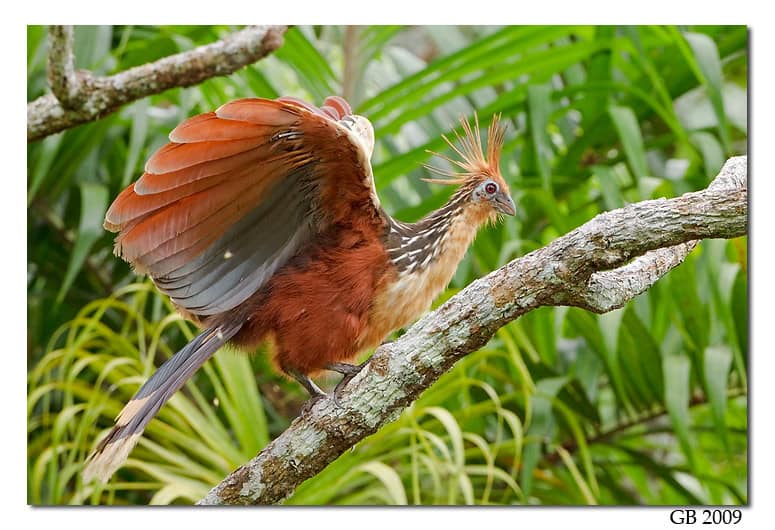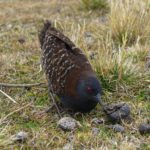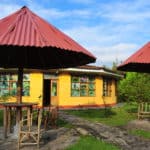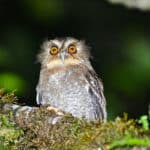Manu National Park
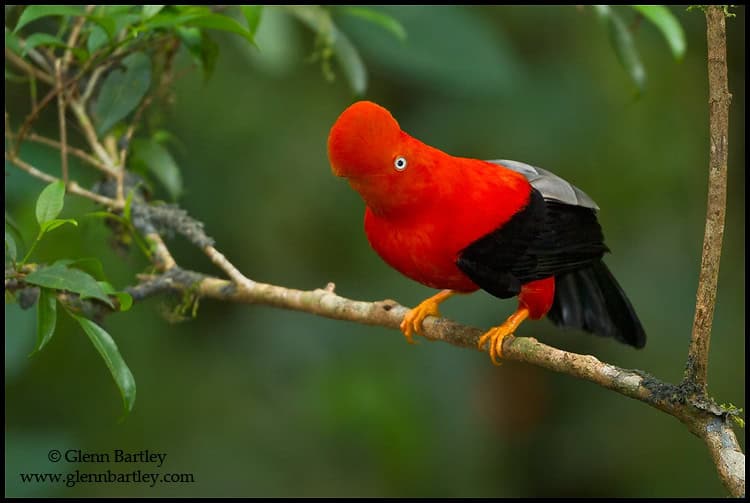 Number One!
Number One!
Manu National Park is the number one birding hotspot on Birdtripper’s list of the Top 100 birding locations in the world. There are a bunch of reasons for that. (Birdtripper’s Top 100 Birding Hotspots is on a member’s only page. Sign up for free now and vote for your favourite hotspot).
Manu National Park has the highest biodiversity of any protected area worldwide. The elevation ranges from the Amazon Basin at 150 metres to the eastern slopes of the Andes at 4200 metres, which contain all types of terrain, including rainforest and high-elevation cloud forest. Wildlife includes Spectacled Bears, 13 species of primates, Giant Otters, Giant Armadillo, sloths, Giant Anteaters, Tapirs, Jaguars and more than 1000 species of birds. Manu National Park became a United Nations World Heritage Site in 1987. The park is enormous. It covers an impressive 17,163 square kilometres (1,716,295 hectares).
Manu National Park is not only a paradise for birders. This mysterious, pristine wilderness is an incredible place for anyone who loves nature and wildlife. Manu is probably the best opportunity to see a Jaguar in the wild.
Four Zones
Manu National Park consists of four distinct zones. The Restricted Use Zone contains native villages; entry is permitted for research only. These indigenous people live by hunting and fishing. They are considered a natural part of the ecosystem and are left to use the park as they please. The Reserved Zone is used for research and recreation, such as birding. The Recuperation Zone is an area undergoing recovery to return to its natural state. Finally, there is the Cultural Zone, which is open for human habitation.
The Birds
Manu National Park is teeming with birds. Half of all the species found in South America can be seen here. The number of species that exist here is equal to about one-tenth of all the birds in the world. Therefore, it has more bird diversity than any other place on earth. The species are distributed according to their preferred habitat and elevation. This is why Birdtripper has chosen Manu National Park as the number one birding hotspot in the world. (see Birdtrippers Top 100 for logged in Members only)
There are enough birds to keep a birder busy for a lifetime, yet many of them are easy to find. Manu National Park is remote yet easy to get to. Here are a few of the most sought-after species.
Andean Cock-of-the-Rock
This weird-looking bird belongs to the Cotinga family (photo at top). It is the national bird of Peru. The bird has a large crest, but unlike any other crested bird, the crest is at the front of the head instead of on the back. It looks like a large tumour, but the pretty orange/red colour prevents it from being an ugly bird. Although it has a huge head, it has a tiny bill that is usually invisible. You have to see this one to believe that it is real.
Andean Condor
The Andean Condor is one of the largest flying birds in the world. With a wingspan of 3.3 metres (10 ft 10″), only four birds are larger (two species of Albatross and two Pelicans). A sighting of this giant vulture will amaze you.
Hoatzin
This strange bird is the only species in its family. It looks like a chicken that stuck its toe into an electric socket. It is the size of a pheasant, with a length of 65 cm (26 inches). The Hoatzin is relatively common in Manu, NP. Be sure to get a photo of this weird bird to show your friends when you get home.
More than 1000 species
Here are just a few of the more than 1,000 species of birds to be seen in Manu National Park: Horned Screamer, Chilean Flamingo, Zigzag Heron, Harpy Eagle, Ornate Hawk-eagle, 29 other hawks and 15 falcons, seven species of Macaws plus 22 parrots, Sungrebe, Sunbittern, Oilbird, Andean Potoo, Sword-billed Hummingbird, Masked Trogon, Swallow-wing, Scarlet-hooded Barbet, Trilling Tapaculo, Mountain Cacique, 12 species of Manakins and an incredible 89 species of stunning Tanagers. Top this off with 84 species of Antbirds, Antthrushes and Antpittas.
The Clay Licks
The Blanquillo Clay Lick attracts hundreds of parrots of several species every day. They go there to eat the mineral-rich clay. You can view birds from a floating blind in the river.
Viewing Tower
There is a canopy tower in a giant Ceiba Tree.
Practical Information
Manu National Park has two seasons. The rainy season lasts from December to March. During this time, there is rain almost every day with the possibility of torrential downpours. As a result, the forest floor will be covered in muddy water, and rivers could be flooded. Months with somewhat less rain are April, October and November. Do not attempt to drive the Manu road during the wet season. The road is prone to mudslides.
The dry season is from mid-April to September. Although there is much less rain and it is easy to walk the trails in the forest, there are drawbacks to going in this season. The weather can be uncomfortably hot and steamy, smotheringly humid. The good news is that there are fewer mosquitoes in this type of weather than in the wet season.
Considering all factors, I think the best time to go would be from mid-April to the end of November. This includes some rainy season but not the worst months of January to March.
Regarding the weather and mosquitoes, the best clothing is loose-fitting, long pants and long-sleeve shirts. Mosquitoes can bite through tight-fitting clothes such as T-shirts. You will also need a good rain suit, a wide-brimmed hat, and insect repellant. Tip: Bring some plastic bags to keep things dry if your backpack is not waterproof.
The temperature varies with the altitude, from an average of 25 C in the temperate forest to only 8 C in the Andes.
Tours and Accommodations Manu NP
I prefer independent birding, but sometimes I use a tour company or a guide. It depends on the circumstances. For Manu National Park, you should go on an organised tour. It is challenging to travel to Manu on your own. The roads are treacherous, and Peruvians are known to be some of the worst drivers in the world. They often do not stop at stop signs or red lights and pass when it is hazardous. Most organised tours have drivers accustomed to the needs of more cautious tourists and are very good drivers. Also, the park is immense, and some areas are closed to the public. You will find a lot more birds with a tour company. (check the guides and accommodations pages for Peru).
You will probably want to set aside a few days to visit Machu Picchu.
(M) Write a review
You must be logged in to submit a review. Go to Members page to Log-in or Register
If you decide to go without a guided tour, you can take a bus from Cusco and stay at one of the lodges listed on the accommodations page. However, only lodges on the near side of the park are accessible by bus. Self-driving in Peru is only for Special Forces personnel and others who like to live dangerously. (There is one company that rents vehicles with a driver included. See Kolibri Expeditions on the Guides Page).
Other Birding Hotspots in Peru
Iquitos
Iquitos is a large city in the Amazon basin located at the junction of the Amazon, Itay, and Nanay Rivers. This city of almost half a million people has no roads, making it the world’s largest isolated city. However, you can fly there from Lima.
There is a road from the city to the nearby Reserva Nacional (RN) Allpahuayo-Mishana. This reserve has 475 bird species and more variety of trees than anywhere else on earth. There are 500 tree species per 2.5 acres, and 100 plants are found nowhere else.
Some of the beautiful jungle birds to look for at Allpahuayo-Mishana include the near-threatened White-throated Tinamou, Cinereous Tinamou, the near-threatened Grey-legged Tinamou, Speckled Chachalaca, Green-backed Trogon, Roufos Motmot, Broad-billed Motmot, Yellow-billed Nunbird, Gilded Barbet, Ivory-billed Aracari, Channel-billed Toucan, Yellow-tufted Woodpecker, Scaly-breasted Woodpecker, Cobalt-winged Parakeet, and the Black-headed Parrot.
For tours to RN Allahuayo-Mishana, contact “Peru Travels“. They offer a three-day tour, and they pick you up at the airport and take you to your hotel. You will spend the second night at Zungarocha Lodge, about 20 km from the city in the direction of the reserve. The third day is just a half-day of birding before heading back to the city and to the airport if you are leaving.
Accommodations Iquitos
No accommodations are listed for Iquitos because none cater to birders. However, there are many nice hotels to choose from. The Muyuna Lodge caters to birders, but it is 140 km upriver. For a four-day guided birding trip to Muyuna Lodge, see their website.
In Iquitos, try to get a hotel on the waterfront. Walking along the Malecon (a paved walkway along the shore) can result in great sightings without leaving the city. These include the Lesser Yellow-headed Vulture, Wattled Jacana, Long-billed Tern, and the Sapphire-spangled Emerald.
(M) Write a review
You must be logged in to submit a review. Go to Members page to Log-in or Register
Lago Junin
Inland from Lima lies Lake Junin, located within RN de Junin. This lake offers some difficult-to-find, very local birds. These include the Junin Canastero (a small bird in the Ovenbird family, endemic to central Peru), Junin Grebe (Critically Endangered and found only at Lago Junin), and Junin Rail (Endangered and found only at Lago Junin). Photo courtesy of Cesar Donato Zevallos (click to enlarge).
Other birds you might see at Lago Junin include the Andean Goose, Crested Duck, Yellow-billed Teal, Yellow-billed Pintail, Puna Teal, Andean Duck, White-tufted Grebe, Chilean Flamingo, Puna Ibis, Plumbeous Rail, Andean Coot, Andean Lapwing, Andean Gull, Andean Flicker, Common Miner, Cream-winged Cinclodes, Andean Negrito, Bright-rumped Yellow-finch and Rufous-collared Sparrow.
Getting There! From Lima, take the Labato Express Bus to the town of Ondores (changes buses at Santa Ana). This is a five-hour and 20-minute trip. Other buses will take seven hours.
When you get there, meet up with Cesar Donata Zevallos Bahaldo. It is doubtful that you will find the Junin Grebe or Junin Rail without a guide. Therefore, make arrangements with Cesar ahead of time. You can contact him at 955-835-819 or look him up on Facebook. Besides guiding, he also rents rooms in his house. He can also arrange transportation from Lima if you want to avoid taking the bus.
Three hours on the lake with a boat 380 Sols ($114)
Guiding one day without a boat 160 Peruvian Sols (about $50 US)
Room for rent in Cesar’s house 30 Sols ($9)
Exchange rates are approximate and subject to change.
Lago Junin is more than 4,000 m up in the Andes Mountains, so take precautions if you are prone to altitude sickness.
(M) Write a review
You must be logged in to submit a review. Go to Members page to Log-in or Register
Ulcumano Ecolodge
After birding at Lago Junin, head further inland to Ulcumano Ecolodge. Make arrangements before you leave home. You can call from here to have someone from the lodge pick you up. Ulcumano offers cabins in a forest setting in the mountains. The lodge has 138 hectares of property with several walking trails.
This is a five-hour drive inland from Lago Junin on Highway 107.
Birds you might see at the lodge include Bown Tinamou, Speckled
At Ulcumano Ecolodge, you might even see the Cloud Forest Screech Owl. This near-threatened owl can be found only in a few mountainous regions in Peru and Bolivia. Photos courtesy Eduardo/Ulcumano Ecolodge. (click to enlarge)
(M) Write a review
You must be logged in to submit a review. Go to Members page to Log-in or Register
Owlet Lodge
The Owlet Lodge and the Ulcumano Lodge are listed under both hotspots and accommodations because of the great bird sightings that are possible at these places.
There are many birds at the Owlet Lodge, but the Long-whiskered Owlet is the best. This is probably the only place where you can see this endangered owl in its natural habitat.
Getting There

Getting to the Owlet Lodge is not easy. First, fly from Lima to Tarapoto. Then go to a place called “Autos San Martin”. This is like a bus station but with cars instead of buses. Here you can hire a car with a driver. You must wait until the driver has enough passengers to make the trip worthwhile, usually four people. Pay for two spaces if you want only two people in the back seat instead of three. This is more comfortable, and you will be able to leave sooner. You must change vehicles once or twice if your destination is beyond the Tarapoto Zone (as Owlet Lodge is). The driver will arrange this and meet with your next driver at a designated spot. It is like changing planes at an airport, except it is done on the side of the road. This will cost about $50 per passenger, which is a bargain for this long trip of several hours.
The Owlet Lodge is located on Highway 5N near the village of Yambrasbamba.
You can also go by bus. This is cheaper than the car, but you must change buses several times. First, take a bus to Moyobamba. Then another bus to Nueva Cajamarca. Yet another bus to Pedro Ruiz. Ask the driver to let you off at km 364.5 at the junction of road Belaund Terry. This is a 10-minute drive before the bus gets to Progresso. Make arrangements ahead of time for the lodge to pick you up. They will also pick up guests in the town of Jauja.
(M) Write a review
You must be logged in to submit a review. Go to Members page to Log-in or Register
Huembo Lodge
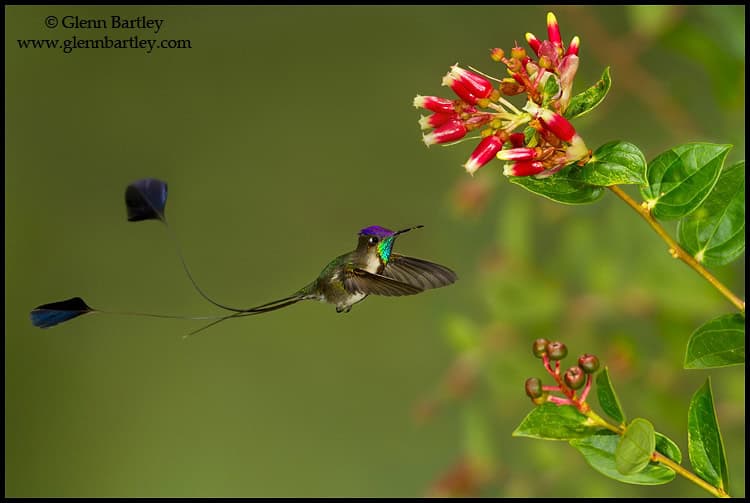 Marvellous Spatuletail
Marvellous Spatuletail
Huembo Lodge, owned by the same people as Owlet Lodge, is 40 minutes drive further along Highway 5N at km 315.7 on the road to Belaunde Terry. Here, you have an excellent chance to see a spectacular hummingbird called the Marvelous Spatuletail.
You need to find this one! It is a beautiful hummingbird with a phenomenal tail. The tail comprises two extraordinarily long feathers and two shorter ones. Each of the longer pair of tails has a feather on the end that looks like a paddle. It makes this hummer look like a cuckoo-clock bird with two crazy pendulums swinging in all directions.
Website for both Owlet and Huembo Lodges: Owlet
(M) Write a review
You must be logged in to submit a review. Go to Members page to Log-in or Register
Gocta Andes Lodge, Cocochimba
The Marvellous Spatuletail can also be seen near the town of Cocochimba. This hummingbird is an endangered species found only in one valley in the Andes Mountains in northern Peru. At Cocachimba, you can also see the Cock-of-the-rock and many other species.
You will need a local guide to see the Marvelous Spatuletail, which is located in a valley below the town. Be prepared to descend about 200 steps and ascend. It is unsuitable for people who are short of breath or have poor hearts.
To get there, continue on Highway 5n until you reach the town of Pedro Ruiz Gallo. Then turn south towards the town of Cocachimba. The turnoff is a bit difficult to find, so you may have to ask a local for directions.
The Gocta Andes Lodge is the best hotel in Cocochimba, and they can arrange tours to see the Marvelous Spatuletail or the Cock-of-the-rock. There are also plenty of cheaper hotels.
(M) Write a review
You must be logged in to submit a review. Go to Members page to Log-in or Register
Other Accommodations Peru
For other accommodations in Peru, see the accommodations page.

